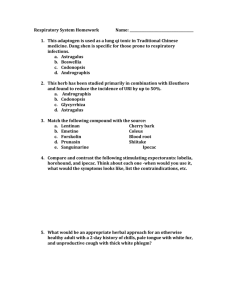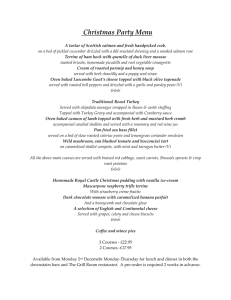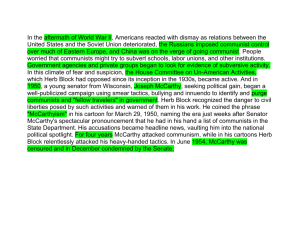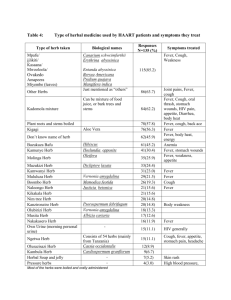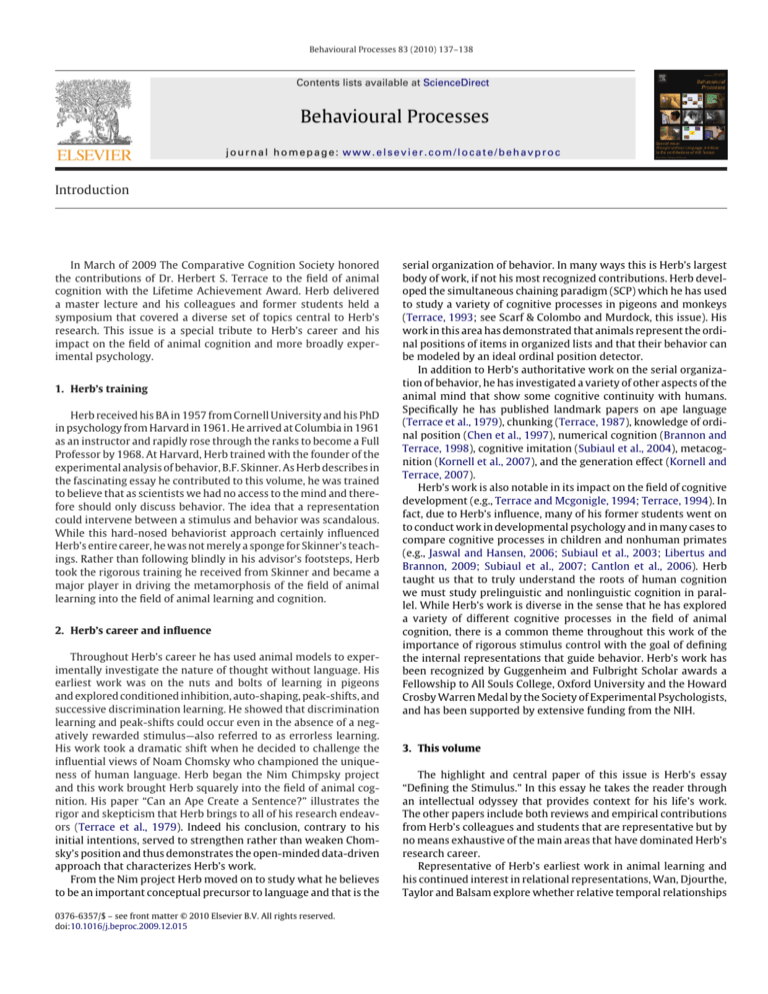
Behavioural Processes 83 (2010) 137–138
Contents lists available at ScienceDirect
Behavioural Processes
journal homepage: www.elsevier.com/locate/behavproc
Introduction
In March of 2009 The Comparative Cognition Society honored
the contributions of Dr. Herbert S. Terrace to the field of animal
cognition with the Lifetime Achievement Award. Herb delivered
a master lecture and his colleagues and former students held a
symposium that covered a diverse set of topics central to Herb’s
research. This issue is a special tribute to Herb’s career and his
impact on the field of animal cognition and more broadly experimental psychology.
1. Herb’s training
Herb received his BA in 1957 from Cornell University and his PhD
in psychology from Harvard in 1961. He arrived at Columbia in 1961
as an instructor and rapidly rose through the ranks to become a Full
Professor by 1968. At Harvard, Herb trained with the founder of the
experimental analysis of behavior, B.F. Skinner. As Herb describes in
the fascinating essay he contributed to this volume, he was trained
to believe that as scientists we had no access to the mind and therefore should only discuss behavior. The idea that a representation
could intervene between a stimulus and behavior was scandalous.
While this hard-nosed behaviorist approach certainly influenced
Herb’s entire career, he was not merely a sponge for Skinner’s teachings. Rather than following blindly in his advisor’s footsteps, Herb
took the rigorous training he received from Skinner and became a
major player in driving the metamorphosis of the field of animal
learning into the field of animal learning and cognition.
2. Herb’s career and influence
Throughout Herb’s career he has used animal models to experimentally investigate the nature of thought without language. His
earliest work was on the nuts and bolts of learning in pigeons
and explored conditioned inhibition, auto-shaping, peak-shifts, and
successive discrimination learning. He showed that discrimination
learning and peak-shifts could occur even in the absence of a negatively rewarded stimulus—also referred to as errorless learning.
His work took a dramatic shift when he decided to challenge the
influential views of Noam Chomsky who championed the uniqueness of human language. Herb began the Nim Chimpsky project
and this work brought Herb squarely into the field of animal cognition. His paper “Can an Ape Create a Sentence?” illustrates the
rigor and skepticism that Herb brings to all of his research endeavors (Terrace et al., 1979). Indeed his conclusion, contrary to his
initial intentions, served to strengthen rather than weaken Chomsky’s position and thus demonstrates the open-minded data-driven
approach that characterizes Herb’s work.
From the Nim project Herb moved on to study what he believes
to be an important conceptual precursor to language and that is the
0376-6357/$ – see front matter © 2010 Elsevier B.V. All rights reserved.
doi:10.1016/j.beproc.2009.12.015
serial organization of behavior. In many ways this is Herb’s largest
body of work, if not his most recognized contributions. Herb developed the simultaneous chaining paradigm (SCP) which he has used
to study a variety of cognitive processes in pigeons and monkeys
(Terrace, 1993; see Scarf & Colombo and Murdock, this issue). His
work in this area has demonstrated that animals represent the ordinal positions of items in organized lists and that their behavior can
be modeled by an ideal ordinal position detector.
In addition to Herb’s authoritative work on the serial organization of behavior, he has investigated a variety of other aspects of the
animal mind that show some cognitive continuity with humans.
Specifically he has published landmark papers on ape language
(Terrace et al., 1979), chunking (Terrace, 1987), knowledge of ordinal position (Chen et al., 1997), numerical cognition (Brannon and
Terrace, 1998), cognitive imitation (Subiaul et al., 2004), metacognition (Kornell et al., 2007), and the generation effect (Kornell and
Terrace, 2007).
Herb’s work is also notable in its impact on the field of cognitive
development (e.g., Terrace and Mcgonigle, 1994; Terrace, 1994). In
fact, due to Herb’s influence, many of his former students went on
to conduct work in developmental psychology and in many cases to
compare cognitive processes in children and nonhuman primates
(e.g., Jaswal and Hansen, 2006; Subiaul et al., 2003; Libertus and
Brannon, 2009; Subiaul et al., 2007; Cantlon et al., 2006). Herb
taught us that to truly understand the roots of human cognition
we must study prelinguistic and nonlinguistic cognition in parallel. While Herb’s work is diverse in the sense that he has explored
a variety of different cognitive processes in the field of animal
cognition, there is a common theme throughout this work of the
importance of rigorous stimulus control with the goal of defining
the internal representations that guide behavior. Herb’s work has
been recognized by Guggenheim and Fulbright Scholar awards a
Fellowship to All Souls College, Oxford University and the Howard
Crosby Warren Medal by the Society of Experimental Psychologists,
and has been supported by extensive funding from the NIH.
3. This volume
The highlight and central paper of this issue is Herb’s essay
“Defining the Stimulus.” In this essay he takes the reader through
an intellectual odyssey that provides context for his life’s work.
The other papers include both reviews and empirical contributions
from Herb’s colleagues and students that are representative but by
no means exhaustive of the main areas that have dominated Herb’s
research career.
Representative of Herb’s earliest work in animal learning and
his continued interest in relational representations, Wan, Djourthe,
Taylor and Balsam explore whether relative temporal relationships
138
Introduction / Behavioural Processes 83 (2010) 137–138
(between a CS and ITI) are transferred in Pavlovian conditioning. Their findings underscore the importance of encoding relative
relationships and how even in Pavolvian conditioning relative
representations may provide representational flexibility. Castro &
Wasserman (this volume) and Katz, Strurz, & Wright (this volume)
explore the effects of stimulus size, spatial organization, and set
size on same-different learning in pigeons. Castro & Wasserman
demonstrate that while pigeons detect changes in both physical
size and spatial arrangements of arrays of items, such changes do
not impair their ability to make same and different judgments. Katz,
Sturz, & Wright present further evidence that restricted-domain
relational learning can often masquerade as item-specific learning.
Representative of Herb’s interest in serial learning and numerical cognition are papers from Murdock, Scarf, & Colombo, Basile &
Hampton, and Jones, Cantlon, Merrritt, & Brannon. In his review,
Murdock, describes a key finding of Herb’s which is that when
monkeys learn lists in the SCP they learn the ordinal position of
each item rather than just item–item associations. Herb and his
colleagues (Chen et al., 1997) demonstrated this by training monkeys on multiple 4-item lists and then testing them with new lists
composed of old items. Some lists maintained each items ordinal
position from its original list and other lists required that each item
be responded to in a new ordinal position. Monkeys were much
quicker to learn the lists where ordinal position was maintained.
Murdock discusses these findings in light of traditional paradigms
used to test human memory and conjectures on the possibility that
his Theory of Distributed Associative Memory (TODAM) could be
used to model these important findings.
Scarf and Colombo used Herb’s SCP to explore whether pigeons
plan ahead when executing sequences from memory. They find
evidence that pigeons plan at least one response ahead. Basile
and Hampton explore whether monkeys are more likely to show
recency effects in the serial probe recognition paradigm when
tested with small compared to large sets. They indeed find stronger
recency effects for small sets and argue that increased familiarity
with items in small sets facilitates rehearsal. Finally, Jones, Merritt,
Cantlon, & Brannon explore the semantic congruity effect in rhesus monkeys and ask whether the context in which a numerical
pair is presented influences the speed of numerical judgments. In a
previous report Cantlon and Brannon (2005) found that monkeys’
numerical judgments show a semantic congruity effect whereby
they are faster to choose the smaller compared to the larger of two
small values but faster to choose the larger than the smaller of two
large values. Here Jones and co-authors show that the semantic
congruity effect is anchored by the range of values in which a given
pair is presented. Thus a pair such as 6 vs. 12 is considered large
when it is the largest pair of values but small when it is the smallest
pair of values presented in a session.
Representative of Herb’s interest in memory and development,
Rovee-Collier & Giles review the state of the art research on the
development of memory. They explain the short comings of the
neuromaturational model of memory development which posits a
hierarchical development of the explicit and implicit memory systems with the explicit memory system emerging late in human
development. They describe a large body of research that supports
an alternative account whereby there is a developmental change in
selective attention resulting in infants and adults selecting different
things to encode.
Papers by Son & Kornell and Metcalfe & Jacobs represent Herb’s
interest in metacognition. Son and Kornell provide a review that
illustrates the virtues and perils of too much or not enough information and describe cutting edge work in both animal and human
metacognition research. Metcalfe and Jacobs provide an original
thesis demonstrating how models of human study-time allocation can benefit from optimal foraging theory. Finally, Subiaul
puts forth a new hypothesis for the evolution of imitation capacities which posits that our capacity for imitation is composed of
content-specific psychological processes that can be dissociated
both structurally and functionally.
4. Conclusion
As one of Herb’s students I am especially grateful for the training
he provided in critical thinking, his emphasis on rigorous stimulus
control, and his ability to inspire cross-disciplinary pursuits with
a true comparative research program. In closing I emphasize that
there is more to come. Herb’s lab remains a vibrant home to many
ongoing projects and I expect that there are quite a few Science and
Nature papers that will soon add to his other classics.
References
Brannon, E.M., Terrace, H.S., 1998. Ordering of the numerosities 1–9 by monkeys.
Science 282, 746–749.
Cantlon, J., Brannon, E.M., 2005. Semantic congruity facilitates number judgments in monkeys. Proceedings of the National Academy of Sciences 102 (45),
16507–16511.
Cantlon, J., Brannon, E.M., Carter, E.J., Pelphrey, K., 2006. Functional imaging of
numerical processing in adults and 4-y-old children. PLOS Biology 4 (5), 1–11,
e125.
Chen, S.F., Swartz, K.B., Terrace, H.S., 1997. Knowledge of the ordinal position of list
items in Rhesus monkeys. Psychological Science 8, 80–86.
Jaswal, V.K., Hansen, M.B., 2006. Learning words: children discount some pragmatic
information that conflicts with mutual exclusivity. Developmental Science 9,
158–165.
Kornell, N., Terrace, H.S., 2007. The generation effect in monkeys. Psychological
Science 18 (8), 682–685.
Kornell, N., Son, L., Terrace, H.S., 2007. Transfer of metacognitive skills and hint
seeking in monkeys. Psychological Science 18 (1), 64–71.
Libertus, M.E., Brannon, E.M., 2009. Behavioral and neural basis of number sense in
infancy. Current Directions in Psychological Science 18 (6), 346–351.
Subiaul, F., Cantlon, J., Lurie, H., Holloway, R., Terrace, H.S., 2003. A re-evaluation of
human and macaque “imitation”: human children and Rhesus macaques do not
qualitatively differ in a copying task. American Journal of Physical Anthropology
120, 204–205.
Subiaul, F., Cantlon, J., Terrace, H., 2004. Cognitive imitation in rhesus macaques.
Science 305, 407–410.
Subiaul, F., Romansky, K., Cantlon, J.F., Klein, T., Terrace, H.S., 2007. Cognitive imitation in 2-year old children (Homo sapiens): a comparison with rhesus monkeys
(macaca mulatta). Animal Cognition 10 (4), 369–375.
Terrace, H.S., 1987. Chunking by a pigeon in a serial learning task. Nature 325,
149–151.
Terrace, H.S., 1993. The phylogeny and ontogeny of serial memory: list learning by
pigeons and monkeys. Psychological Science 4, 162–169.
Terrace, H.S., 1994. Are infants human? Behavioral and Brain Sciences 17, 425–426.
Terrace, H.S., Mcgonigle, B., 1994. Memory and representation of serial order by
children, monkeys, and pigeons. Current Directions in Psychological Science 3,
180–185.
Terrace, H.S., Petitto, L.A., Sanders, R.J., Bever, T.G., 1979. Can an Ape create a sentence? Science 206, 891–902.
Elizabeth Brannon ∗
Department of Psychology and Neuroscience,
Duke University, Center for Cognitive Neuroscience,
Box 90999, Durham, NC 27708 0999, United States
∗ Tel.:
+1 919 668 6201;
fax: +1 919 681 0815.
E-mail address: brannon@duke.edu


